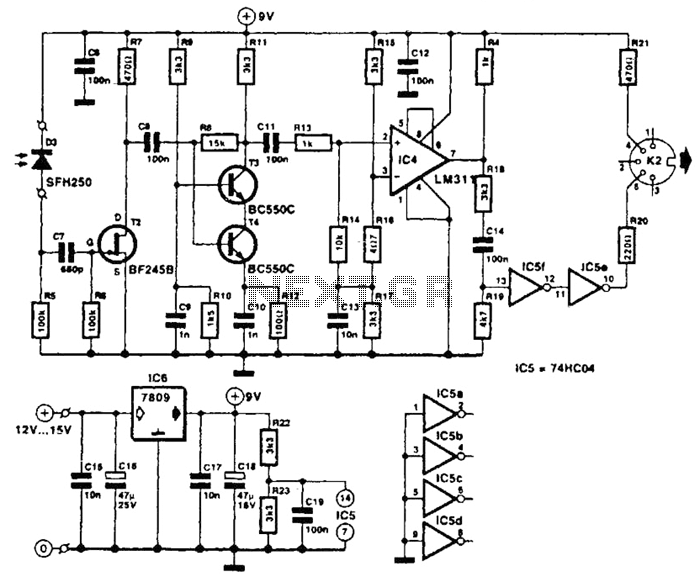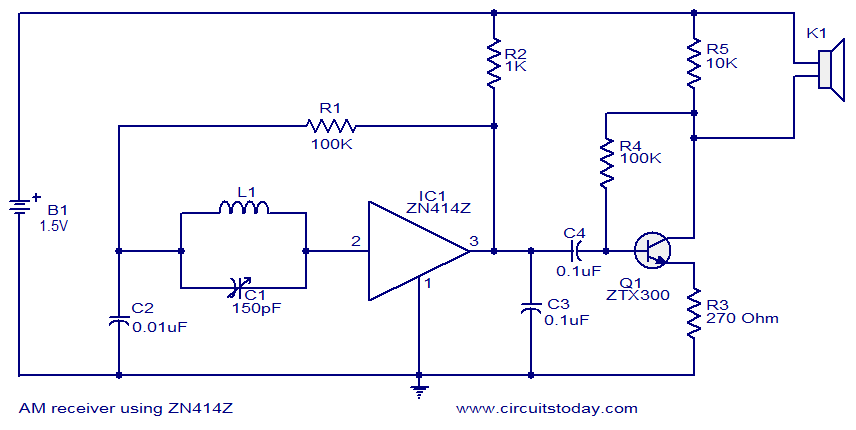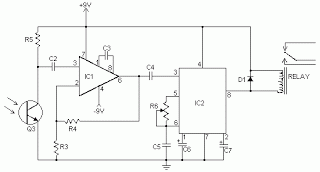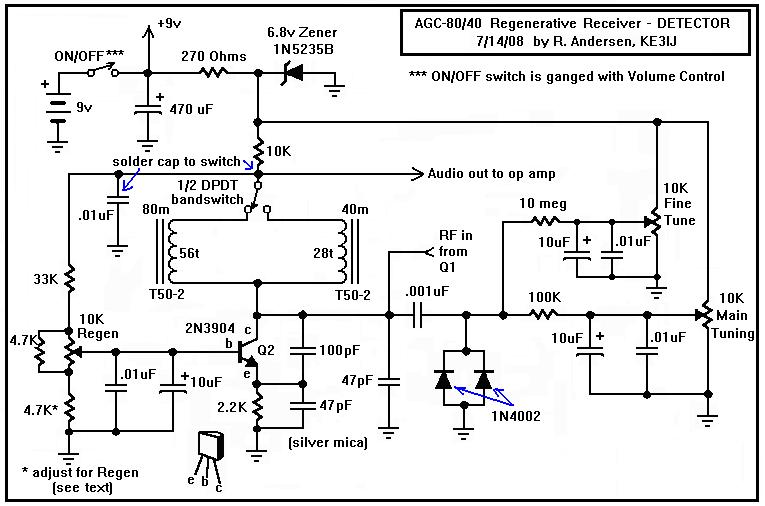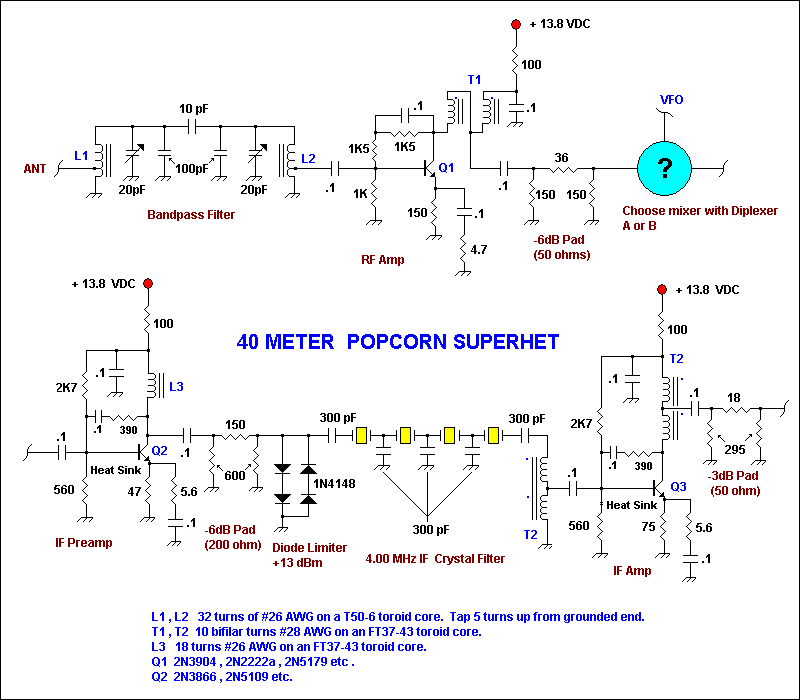
N6EX Receiver Mods
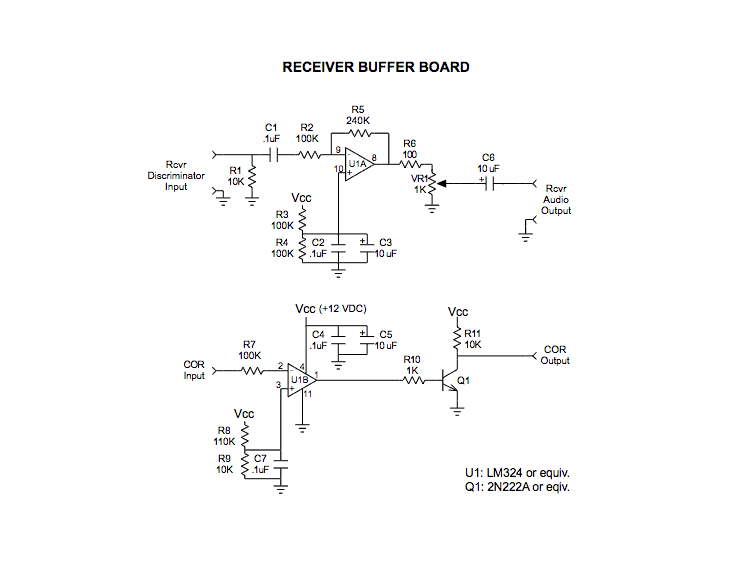
This document outlines the hardware modifications required to adapt a Kenwood TK-931 transceiver for 902 MHz repeater receive operation. It does not include the programming effort needed for the desired operating frequency, which can be performed using Kenwood KPG-5D programming software and a KPG-4 programming cable or equivalent. It is assumed that the receiver functioned correctly in its original frequency range before the modifications. Post-modification check-out and alignment of the receiver is recommended. The overall modification photo displays the audio/buffer interface board installed in the front right section of the receiver's top cavity, near the radio's microprocessor. The board is drilled at the two front corners to align with two unused holes in the radio frame. This area is not only convenient for mounting the interface board but also provides necessary points for receive audio and signal presence. An unsquelched line is preferred for the receive audio signal. The audio switching (squelch) of the TK-931 occurs before the de-emphasis circuitry, ensuring flat audio at any pick-off point. Two accessible pick-off points are near the microprocessor: one is an unfiltered buffered version of discriminator audio, and the other has a sharp filter to eliminate PL and DPL signals below 300 Hz. The frequency response of these points is illustrated in the accompanying plot. Some applications may prefer the low PL frequencies filtered out before being injected into the controller and transmitter; however, the unfiltered point is selected for its flatter response. This point is a via near pin 32 of the microprocessor (IC4), where the solder mask can be removed to solder a small wire connecting this point to the audio input of the Audio/COR interface board. The signal presence line is also accessible on the receiver circuit board near the microprocessor at the intersection of D101 and R118, where a small wire can be attached to the COR input of the Audio/COR interface board. The photo illustrates the interface points for the Audio/COR board, including the discriminator audio pick-off point near the corner of the microprocessor IC (IC4) and the COR input connection between R118 and D101. An alternative audio pick-off point is located on the right side of C121, providing a filtered version of discriminator audio with frequencies below 300 Hz removed. The DC input for the Audio/Interface board can be sourced from the CN1 connector (which connects the front panel to the main circuit board), with switched 13.8 VDC available on pin 2 (SB) and return on pin 3 (GN). Once the Audio/COR board is installed and connected to the receiver interface points, it can be tested and adjusted. The buffer board is utilized to provide a high-level, low-impedance audio source to the controller, significantly enhancing noise immunity. For this specific controller (Arcom RC210), a level of 2 volts peak-to-peak at rated deviation is optimal. A signal generator produces a strong RF signal (-70 dBm) to the receiver, with the generator's deviation set to the maximum rated level (±2.5 kHz) at a modulation rate of 1 kHz. The trimpot on the Audio/COR board is adjusted until 2 volts peak-to-peak is achieved, and it is also verified that the board's COR output transitions from high to low when a signal is applied to the receiver (assuming the squelch is set to operate normally).
The modifications to the Kenwood TK-931 transceiver for 902 MHz repeater operation involve several critical steps to ensure proper functionality and performance. The installation of the audio/buffer interface board is a pivotal modification, as it facilitates the necessary connections for receive audio and signal presence. The location chosen for the interface board is strategic, as it is close to the microprocessor, minimizing the length of the connections and thereby reducing potential interference.
The selection of the audio pick-off points is essential for maintaining audio quality. The unfiltered discriminator audio provides a broader frequency response, which can be advantageous for applications where audio fidelity is paramount. The choice to use this point instead of the filtered version reflects a preference for a flatter response curve, which is particularly useful in digital communication systems where signal integrity is crucial.
The integration of the Audio/COR interface board into the system not only enhances the audio output level but also improves noise immunity. This is particularly important in environments with high electromagnetic interference, where maintaining a clear signal is essential for reliable communication. The use of a trimpot for fine-tuning the output level allows for precise adjustments, ensuring compatibility with various controllers.
The documentation emphasizes the importance of post-modification check-out and alignment, which is critical for ensuring that the transceiver operates within specified parameters after the hardware changes. This step is vital for maintaining the performance and reliability of the transceiver in its new operational context.
Overall, these modifications represent a thorough approach to adapting the Kenwood TK-931 transceiver for enhanced performance in the 902 MHz band, ensuring that users can achieve optimal communication results.This page identifies all the hardware modifications necessary to adapt a Kenwood TK-931 transceiver for 902 MHz repeater receive operation. Not shown here is the effort required to program the radio for the desired operating frequency. This is accomplished using the Kenwood KPG-5D programming software and KPG-4 programming cable, or equivalent.
It also assumes that the receiver portion of the radio was properly operating in its original frequency range prior to modification. Check-out and alignment of the receiver after modification is recommended. The overall receiver modification photo shows the audio/buffer interface board installed in the front, right section of the top cavity of the receiver.
This area is located near the microprocessor of the radio. The board is drilled on the two front corners to coincide with two unused holes in the radio frame. Not only is this area of the radio available for convenient mounting of the interface board, but it also provides the necessary interface points for receive audio and signal present. For the receive audio signal, an unsquelched line is preferred. The audio switching (squelch) of the TK-931 is done prior to the de-emphasis circuitry, therefore any pick-off point will have flat (relatively) audio.
Two easily accessible pick-off points are available in the vicinity of the microprocessor. One point is an unfiltered buffered version of discriminator audio. There is another point that has a sharp filter to remove the PL and DPL signals below 300 Hz. The plot below shows the frequency response of the two points. While some applications may prefer having the low PL frequencies filtered-out prior to injection into the controller and transmitter, I chose to use the unfiltered point. The unfiltered discriminator point offers a much flatter response as compared with the filtered point.
This point is a via located near pin 32 of the microprocessor (IC4). The soldermask can be removed and a small wire can be soldered between this point and the audio input of the Audio/COR interface board. The signal present line is also directly available on top of the receiver circuit board in the vicinity of the microprocessor.
This point is at the intersection of D101 and R118. A small wire can be attached between this point and the COR input of the Audio/COR interface board. This photo shows the interface points for the Audio/COR board. The small via near the corner of the microprocessor IC (IC4) is the discriminator audio pick-off point. The COR input to the buffer board can be wired to the interface between R118 and D101 of the receiver board.
The photo also shows the alternative audio pick-off point. This point is located on the right side of C121. It is a filtered version of discriminator audio that has frequencies below 300 Hz removed. DC input to the Audio/Interface board can be taken from the CN1 connector (connects front panel to main circuit board). Switched 13. 8 VDC is on pin 2 (SB) and return is on pin 3 (GN). Once the Audio/COR board is installed and connected to the receiver interface points, the board can be checked and adjusted.
One of the reasons the buffer board is used is to provide a high level, low impedance audio source to the controller, thereby greatly improving noise immunity. With this particular controller (Arcom RC210), a level of 2 volts peak-to-peak at rated deviation level was found to work well.
A signal generator is used to produce a strong RF signal (-70 dBm) to the receiver. The deviation on the generator is set to maximum rated deviation (in this case +/- 2. 5 kHz) at a modulation rate of 1 kHz. The trimpot on the Audio/COR board is adjusted until 2 volts peak-to-peak is observed. Also verify that the COR output of the board goes from high to low when signal is applied to the receiver (assumes squelch is set to open and close normally). To interface the TK-931 receiver to the controller, the accessory conn 🔗 External reference
The modifications to the Kenwood TK-931 transceiver for 902 MHz repeater operation involve several critical steps to ensure proper functionality and performance. The installation of the audio/buffer interface board is a pivotal modification, as it facilitates the necessary connections for receive audio and signal presence. The location chosen for the interface board is strategic, as it is close to the microprocessor, minimizing the length of the connections and thereby reducing potential interference.
The selection of the audio pick-off points is essential for maintaining audio quality. The unfiltered discriminator audio provides a broader frequency response, which can be advantageous for applications where audio fidelity is paramount. The choice to use this point instead of the filtered version reflects a preference for a flatter response curve, which is particularly useful in digital communication systems where signal integrity is crucial.
The integration of the Audio/COR interface board into the system not only enhances the audio output level but also improves noise immunity. This is particularly important in environments with high electromagnetic interference, where maintaining a clear signal is essential for reliable communication. The use of a trimpot for fine-tuning the output level allows for precise adjustments, ensuring compatibility with various controllers.
The documentation emphasizes the importance of post-modification check-out and alignment, which is critical for ensuring that the transceiver operates within specified parameters after the hardware changes. This step is vital for maintaining the performance and reliability of the transceiver in its new operational context.
Overall, these modifications represent a thorough approach to adapting the Kenwood TK-931 transceiver for enhanced performance in the 902 MHz band, ensuring that users can achieve optimal communication results.This page identifies all the hardware modifications necessary to adapt a Kenwood TK-931 transceiver for 902 MHz repeater receive operation. Not shown here is the effort required to program the radio for the desired operating frequency. This is accomplished using the Kenwood KPG-5D programming software and KPG-4 programming cable, or equivalent.
It also assumes that the receiver portion of the radio was properly operating in its original frequency range prior to modification. Check-out and alignment of the receiver after modification is recommended. The overall receiver modification photo shows the audio/buffer interface board installed in the front, right section of the top cavity of the receiver.
This area is located near the microprocessor of the radio. The board is drilled on the two front corners to coincide with two unused holes in the radio frame. Not only is this area of the radio available for convenient mounting of the interface board, but it also provides the necessary interface points for receive audio and signal present. For the receive audio signal, an unsquelched line is preferred. The audio switching (squelch) of the TK-931 is done prior to the de-emphasis circuitry, therefore any pick-off point will have flat (relatively) audio.
Two easily accessible pick-off points are available in the vicinity of the microprocessor. One point is an unfiltered buffered version of discriminator audio. There is another point that has a sharp filter to remove the PL and DPL signals below 300 Hz. The plot below shows the frequency response of the two points. While some applications may prefer having the low PL frequencies filtered-out prior to injection into the controller and transmitter, I chose to use the unfiltered point. The unfiltered discriminator point offers a much flatter response as compared with the filtered point.
This point is a via located near pin 32 of the microprocessor (IC4). The soldermask can be removed and a small wire can be soldered between this point and the audio input of the Audio/COR interface board. The signal present line is also directly available on top of the receiver circuit board in the vicinity of the microprocessor.
This point is at the intersection of D101 and R118. A small wire can be attached between this point and the COR input of the Audio/COR interface board. This photo shows the interface points for the Audio/COR board. The small via near the corner of the microprocessor IC (IC4) is the discriminator audio pick-off point. The COR input to the buffer board can be wired to the interface between R118 and D101 of the receiver board.
The photo also shows the alternative audio pick-off point. This point is located on the right side of C121. It is a filtered version of discriminator audio that has frequencies below 300 Hz removed. DC input to the Audio/Interface board can be taken from the CN1 connector (connects front panel to main circuit board). Switched 13. 8 VDC is on pin 2 (SB) and return is on pin 3 (GN). Once the Audio/COR board is installed and connected to the receiver interface points, the board can be checked and adjusted.
One of the reasons the buffer board is used is to provide a high level, low impedance audio source to the controller, thereby greatly improving noise immunity. With this particular controller (Arcom RC210), a level of 2 volts peak-to-peak at rated deviation level was found to work well.
A signal generator is used to produce a strong RF signal (-70 dBm) to the receiver. The deviation on the generator is set to maximum rated deviation (in this case +/- 2. 5 kHz) at a modulation rate of 1 kHz. The trimpot on the Audio/COR board is adjusted until 2 volts peak-to-peak is observed. Also verify that the COR output of the board goes from high to low when signal is applied to the receiver (assumes squelch is set to open and close normally). To interface the TK-931 receiver to the controller, the accessory conn 🔗 External reference
